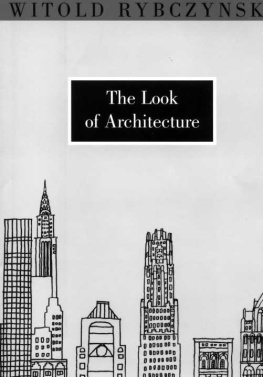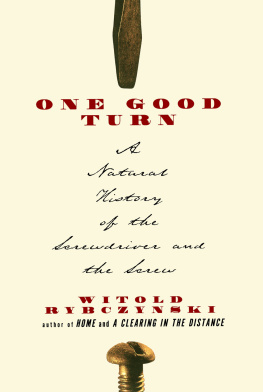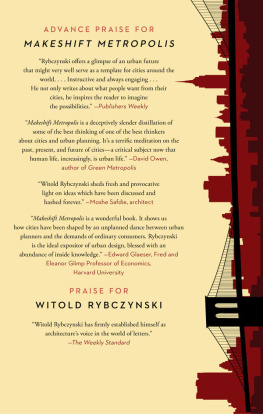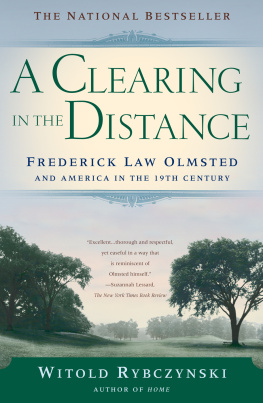
Witold Rybczynski has written about architecture for The New Yorker , The New York Times , and Slate . Among his award-winning books are Home , The Most Beautiful House in the World , and A Clearing in the Distance , which won the J. Anthony Lukas Book Prize. Winner of the 2014 National Design Award and the Vincent Scully Prize, he lives with his wife in Philadelphia, where he is a professor emeritus of architecture at the University of Pennsylvania. Learn more about Rybczynski at his website, www.witoldrybczynski.com. Or sign up for email updates here.

ALSO BY WITOLD RYBCZYNSKI
Paper Heroes
Taming the Tiger
Home
The Most Beautiful House in the World
Waiting for the Weekend
Looking Around
A Place for Art
City Life
A Clearing in the Distance
One Good Turn
The Look of Architecture
The Perfect House
Vizcaya (with Laurie Olin)
Last Harvest
My Two Polish Grandfathers
Makeshift Metropolis
The Biography of a Building
How Architecture Works
My first essay collection, Looking Around , was published in 1992. Much has changed in the intervening two decades. For one, I moved from Canada to the United States. The move did not provide me with new publishing opportunities, because except for the Canadian monthly Saturday Night the places where my journalistic writing appeared were mostly American newspapers and magazines. But crossing the border involved a major change. When I wrote about American buildings and cities while living in Canada, I did so as an outsider. It was easy to write about American urbanism, for example, from the comfortable vantage point of rural Quebec and quite another thing to be surrounded by the problems of a declining Rust Belt city such as Philadelphia, where I now live.
Another change has been the spread of the Internet. In the 1990s, I was still consulting my dictionary and thesaurus, leafing through library card catalogs, squinting at microfiche readers, and prowling the stacks of the university library. By the end of that decade, however, my computerincreasingly at homehad become my chief research tool. The Internet did not just change the way I searched for information; it also provided many new places to read about architecture. When I started writing, the only architecture critic I read with any regularity was Paul Goldberger in the Sunday New York Times . I was aware of Allan Temko and Robert Campbell, but I had no access to either the San Francisco Chronicle or The Boston Globe , nor to the handful of other newspapers that had architecture critics. As for the architecture magazines, they contained little reading matter; I only looked at the pictures.
The Internet changed all that. Newspapersfrom here and abroadare available online, and I can read about architecture in the Los Angeles Times , the Toronto Globe and Mail , and The Guardian . Online architecture columns, blogs, and websites have proliferated. Moreover, Internet blogs have spurred the architecture magazinesand their websitesto publish critical prose again. Is this a new golden age of architectural writing? Not quite. While there is more writing about architecture than ever before, the quality is not high. Posts on the Web do not receive close editing and fact-checking. Moreover, while there is more coverage of architecture than ever before, the range of opinions expressed is surprisingly narrow; on the Internet, the herd instinct prevails. In part this is due to the lack of time for reflection, and in part it is the nature of mass culture, which favors entertainment over reflection, leading to oversimplification and caricature rather than considered judgment. And when critical disagreement does occur, as it has over Gehrys proposed design for the Eisenhower Memorial, it tends to take the form of people shouting at each other, an architectural Firing Line .
If there was a golden age of architectural prose, it might have been the 1960s and 1970s, thanks to magazines such as The Architectural Forum in the United States and AD in Britain, the criticism of Lewis Mumford, Reyner Banham, and Martin Pawley, and the scholarship of John Summerson, James Ackerman, Nikolaus Pevsner, and Vincent Scully. These writers have remained, for me, models of how one ought to write about architecture.
I have had the luxury of picking my own topics rather than being assigned subjects, so if the choice sometimes seems eccentric, there is no one to blame but myself. I have been given the opportunity to write for a wide variety of publications: newspapers, monthly magazines, book reviews, quarterlies, and literary journals. I would like to acknowledge my editors, especially Bill Whitworth and Corby Kummer at The Atlantic Monthly , Henry Finder at The New Yorker , Robert Silvers at The New York Review of Books , Holly Eley at The Times Literary Supplement , Jay Tolson and Steven Lagerfeld at The Wilson Quarterly , John Fraser at Saturday Night , and Nathan Glazer at The Public Interest . For seven years, I was the architecture critic for Slate . I have not included any of my Slate posts in this collection, but I learned a lot from Jacob Weisberg, Meghan ORourke, and Julia Turner.
I agree with William Wursters wise observation that architecture is the picture frame and not the picture, and I have written about the broader setting of our metropolitan world and the even broader context of modern life. Mysteries of the Mall, The Fifth City, The Master, A Distinguished Failure, and Call Arup appeared in The New York Review of Books ; Downsizing Cities, Show Dogs, A Good Public Building, and Sounds as Good as It Looks in The Atlantic ; Downtown, Why We Need Olmsted Again, and Why Wright Endures in The Wilson Quarterly ; Tomorrowland and Designs for Escape in The New Yorker ; The Story King and The Biggest Small Buildings in Architecture ; A Humble Architect and The Zen Master in The Walrus .
The Unreal America appeared in The New York Times Book Review ; Big-City Amenities. Trees. High-Tech Jobs. Cappuccino. Retirement Paradise. Nose Rings in The New York Times Magazine ; New Yorks Rumpus Room in The New York Times ; When Buildings Try Too Hard in The Wall Street Journal ; Were All Venetians Now in the Financial Times ; The Smart Man from Hollywood in The Times Literary Supplement ; Mr. Success in The Washington Post s Book World ; A Blight at the Opera in Saturday Night ; Bauhaus Blunders in The Public Interest ; Tocqueville, Urban Critic in City Journal ; Palladio in the Rough in The American Scholar ; Thoughts on Home in Apartamento ; Godfathers of Sprawl in the Wharton Real Estate Review ; and Bollard Burg in Foreign Policy . Corbu was written for Time/CBS Newss People of the Century (1999). The Unfettered Eclectic was written as an introduction to Robert A. M. Stern: Houses and Gardens (2005).
I have written more than 350 essays and book reviews since Looking Around . The task of culling a manageable and meaningful collection from this motley output and editing the result for grammatical consistency and to eliminate redundancy fell to my supportive editor, Eric Chinski; thanks too to Peng Shepherd, Susan Goldfarb, and all the rest at FSG.
Most of us dont attach much importance to the mundane architectural settings of our everyday lives. We go in and out of supermarkets, fast-food restaurants, and gas stations without a second thought, perhaps because we understand these places so well that they seem merely a part of our natural surroundings. Its necessary to think back to childhood to recall what it was like when such ordinary places were new and strange. I remember my first schoolroom, with its imposing hierarchy of many little desks and one big, important desk. Or the first time I was taken to a museum, with its succession of large, silent rooms filled with labeled glass cases. Or the first, truly strange experience of a movie theater: sitting alonein a crowdin the dark. As children, we unravel these unknown, exotic places like anthropologists in a new world, without the encumbrance of foreknowledge. We are obliged to decipher for ourselves the meanings of each new place, and to find our own place in it.
Next page






